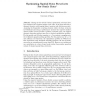Free Online Productivity Tools
i2Speak
i2Symbol
i2OCR
iTex2Img
iWeb2Print
iWeb2Shot
i2Type
iPdf2Split
iPdf2Merge
i2Bopomofo
i2Arabic
i2Style
i2Image
i2PDF
iLatex2Rtf
Sci2ools
IGIS
1994
1994
Optimizing Spatial Data Structures For Static Data
During the last decade various spatial data structures have been designed and compared against each other, all of them re ecting a dynamic situation with ongoing object insertion and deletion processes. Assuming the frequently occurring situation where the data is known in beforehand and using as performance measure the expected number of data bucket accesses needed to perform a window query, the original dynamic clustering problem turns into a classical optimization problem. For the special case of bucket capacity cb = 2 we present a mapping onto the well-known graph matching problem. For the general case of cb 3 and arbitrary cost functions, the optimization problem is NP-hard. In rst experiments with simulated annealing heuristics the best dynamic structures are outperformed by more than 25%. However, we understand our contribution as a lower bound result rather than another speed-up variant of classical spatial data structures.
| Added | 10 Aug 2010 |
| Updated | 10 Aug 2010 |
| Type | Conference |
| Year | 1994 |
| Where | IGIS |
| Authors | Lukas Bachmann, Bernd-Uwe Pagel, Hans-Werner Six |
Comments (0)

